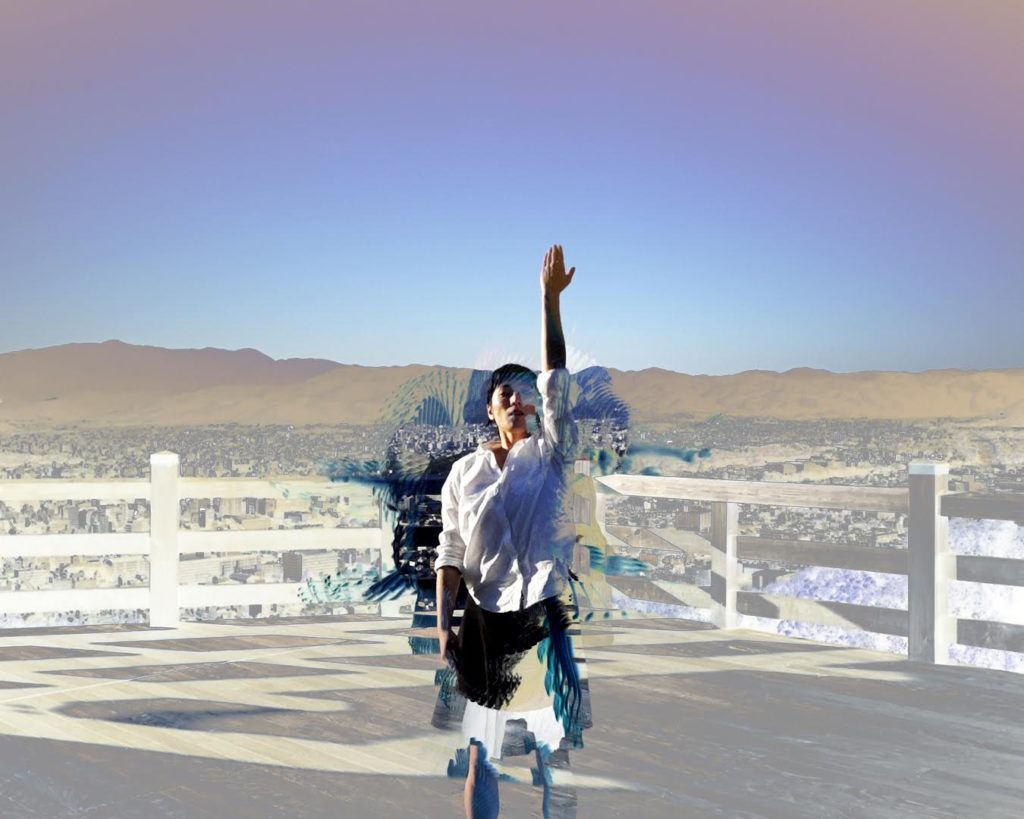A Place to Bury Everything I Did
Alexandre Maubert
7 November, 2016 – 23 January, 2017
Opening night reception: 7 November, 19:30 – 21:30
Live dance performance by Kyoko Nomura
Photographing
Opening night reception: 5 December, 19:30 – 21:30
Displaying works
Launch of publication
© Alexandre Maubert, 2016. Rehearsing with Kyoko Nomura.
.
| 「ハプニングと日常生活の間の境界は流動的に、そして出来るだけ不明瞭に留めるべきである。」
— アラン・カプロー
ドゥルーズとガタリが1972年にアンチ・オイディプスの中で「脱領土化」の言葉を作った当時は、21世紀の仮想世界を夢描くだけでした。脱領土化と仮想性の両方の概念は、その時ではまだ抽象的な哲学觀念であり、現代の資本主義文化とその流動性の中での人間の主観性の性質を示すのみでした。現在では、技術向上とインターネットの偏在、そしてスマートフォンと低価格での航空旅行によって、地域文化の独自性は徐々に緩い観点になってきており、実際の距離と独特な文化の違い – 觀念論と美的価値 – は更に段々と曖昧になっています。 日本の京都に居住するフランス人作家のアレクサンドル・モベールは、映画とビデオから写真、彫刻、絵画までの様々な分野にまたがる作品を通してこれらのアイディアを模索しています。時間と空間がどの様に、地域文化と実際の芸術作品の制作段階の場を繋げるかの要約が、モベールの最終的な展示作品で中心的な重要性を持ちます。 The Containerでのモベールの展覧会、A Place to Bury Everything I Did (自らの行い全てを埋める場所) は、展示作品の制作への道具として活用される、展覧会の空間である運送コンテナの、実際の構造が見られる時間ベースの写真によるインスタレーションです。モベールはThe Containerの制限された空間、形態、そしてほの暗い性質を利用して、本ギャラリーの空間を展示予定の写真シリーズを撮影する等身大のピンホール・カメラへと転換させます。マウバートの長期に及ぶライブ・パフォーマンス、音楽、そしてダンスへの興味がこれら作品の制作にて中心的な位置を占めており、観覧者は作家の当座しのぎな「アトリエ」の見物人、そして展示作品の制作への重要な貢献者になります。本展覧会は2つの異なる「初日イベント」を開催する予定で、一つは来客前での作品制作、そしてもう一つは実際の作品展示となります。 最初のイベントでは、観覧者は展示会スペースである実際のコンテナに入場することは出来ません。その代わりに、コンテナは閉扉して暗い状態を維持し、ピンホール・カメラとして機能します。そこでは実際のコンテナの壁に計算的にドリルで開けた多数の穴を経由して、空間を貫く光の光線が、一回に一度、光感応の写真乳剤で覆われた様々な表面へと像を捕らえます。 これら写真の主題は、日本人ダンス振付師兼ダンサーである野村香子(福岡生まれで現在は京都に居住)によるライブ・ダンスパフォーマンスであり、展覧会としてだけではなくアートの発生としてイベント中に観客の前で踊ります。二回目のイベントは一ヶ月後に予定しており、ライブ・パフォーマンスからの画像を展覧会場に設置する従来の展覧会となります。展覧会の期間中、画像は会場に展示されます。
|
“The line between the Happening and daily life should be kept as fluid, and perhaps indistinct, as possible.”
— Allan Kaprow
When Deleuze and Guattari coined the term “deterritorialization” in Anti-Oedipus in 1972, they could only dream of our 21st century world of virtuality. Both concepts of deterritorialization and virtuality, at the time, were still only abstract philosophical notions, denoting the nature of human subjectivity in contemporary capitalist cultures and its fluidity. Nowadays, with technological advances and the ubiquity of the internet, smartphones, and inexpensive air travel, local cultural identity is increasingly becoming a looser term, where physical distance and distinct cultural differences—conceptual and aesthetic—become more and more blurred. Alexandre Maubert, a French artist residing in Kyoto, Japan, has been exploring these ideas through a variety of interdisciplinary works, from film and video, to photography, sculpture, and painting; encapsulating how time and space bridge between cultural locality, and where the actual art-creating processes take pivotal significance in his final exhibited pieces. Maubert’s exhibition at The Container, A Place to Bury Everything I Did, is a time-based photographic installation that sees the actual construction of the exhibiting space—a shipping container—utilized as a tool for the creation of the exhibited works. Maubert takes advantage of the limited space, shape, and dim nature of The Container to turn it into a life-size pinhole camera to take a series of photographs that will be shown at the gallery. His long-standing interest also live performance, music, and dance, take center stage in the creation of these works, where the visitors become spectators in his make-shift “studio” and, indeed, key contributors to the creation of the exhibited pieces. The exhibition will see two different “opening night events,” one to create the pieces in front of an audience, and another, to showcase the actual works. During the first event, spectators will not be able to enter the actual container, the exhibition space. Instead, the container will remain closed and dark, serving as a pinhole camera, where rays of light penetrate the space through a numbers of holes, strategically drilled into the walls of the actual container—capturing images, one at a time, onto a variety of surfaces coated with light sensitive photographic emulsion. The subject of these photographs is a live dance performance by the Japanese choreographer and dancer, Kyoko Nomura (born in Fukuoka, currently based in Kyoto), who will be dancing during the event, in front of the spectators, in what is more akin to an art happening than a private view of an exhibition. The second event, scheduled to take place a month later, will see a more traditional private view event with the images taken from the live performances installed inside of the exhibition space. The images will remain in the space for the duration of the exhibition.
|
